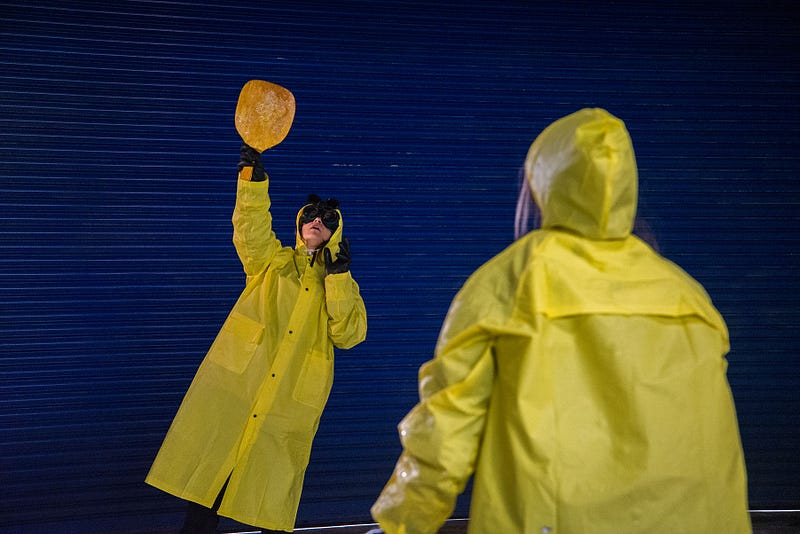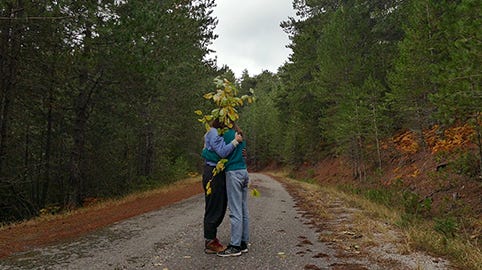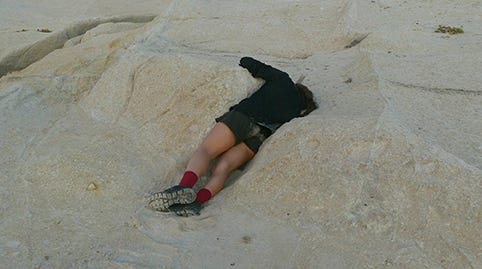06.04.2022
All bodies have a performative potential
Dance
A conversation between dance artist Aria Boumpaki and curator Eva Vaslamatzi
E.V.
I would like to focus on projects that are entirely yours, that is, that start from your own idea and initiative, such as the Handle with care project that you recently presented at the Snehta space in Kypseli, Compost (2019) and the 162 dance meetings (2017). Let’s start with Compost, which is a special experiment of collaboration between two dancers (Christina Reinhardt, Konstantinos Papanikolaou), a visual artist (Ioanna Plessa), a sound artist (Anouk Arra), a gardener (Athena Geraniou) and a cook (Manolis Pipinis). How did the dialogue between these different fields work?
Α.Β.
Initially, for three months we all coexisted together in the Bluebox studio and each of us gained something from the other’s creative process, without them necessarily being artistic processes. If someone is cooking in the same place where I dance, how can the smell affect my movement? Or vice versa, what changes in the way one cooks when a body is dancing next to them? What interests me is the process of sharing, the participants entering all together into a moving process but not into something very specific, like a choreography. As Konstantinos Papanikolaou, who participated in Compost, told me, it is like trying to bring life into the process. In the same way that life on a given day can be very boring — something which is normal -, the performance itself can sometimes be boring if, for example, you arrived at the studio at a moment where very little was happening. In this project I wanted to take this risk; I avoided pushing myself for a result, trying not to be dragged down by the anxiety of success.

Ε.V.
A challenging aspect of your work is that you provide a “stage” for bodies of non-dancers. You also did this in the project 162 dance meetings in the context of the Young Choreographers Festival at the Onassis Foundation.
Α.B.
In the project 162 dance meetings there were also non-dancers and non-professionals, none of whom had anything to do with dance. At Compost some were non-dancers but they were professionals, I mean in their field.
E.V.
Did those who were not dancers in the Compost project dance at the end?
Α.B.
The cook did not dance, the gardener developed a kind of kinetic sensibility. To me, it seems that all bodies have a performative potential. There is beauty in everyone’s personal movement. My role is to create situations so that each participant feels safe to enter the kinetic situation.
How do you create this condition?
Α.B.
For the 162 dance meetings I had individual meetings with the 81 participants in a garage in the neighborhood of Neos Kosmos. I had created artistic worlds, such as an environment and costumes that allowed them to cut themselves off from their daily lives and feel more freedom and comfort to express themselves. Each meeting was followed by a small ritual. I met them outside, holding a carnation so that they could recognize me, and we made our way to the studio together. Once there, we took time to get acquainted with the place, having tea and holding a first discussion about what would follow in the room that I had specially designed. At the end of the process we returned to the table for a closing discussion. The space was very important for the ritual, especially the opening and closing of the garage door — many had difficulty getting out after the process, experiencing it as a return to reality.

E.V.
And finally, after all these meetings, how did you manage to isolate what you were kinetically interested in?
Α.B.
The choreography was an account of what “remained” in my body from these encounters. I had gotten used to meeting four people per day, and the loneliness I felt when these meetings ended was prohibitive. At this point I realized how important the meetings were and how difficult it was to move on to create a choreography out of them.
E.V.
What is the relationship you develop with each space, which in your works so far is not a typical stage?
Α.B.
I’m not attracted to the stage, at least for now. I like the idea that we inhabit spaces with our processes, that we occupy a space and invite the public to enter into this condition. Because the process is very important in my work, I cannot separate the space from it. Through the process, the space itself acquires another weight in relation to the movement, but I also feel that the movement is weakened when it leaves the space where it was created. Yet I do not feel that I do site specific works or public art. I am interested in the vulnerability of the project itself and the people who take part in it. The stage neutralizes this vulnerability.

E.V.
You have taken up classical dance studies in Greece; When did you start to be interested in more experimental and hybrid forms of dance?
Α.B.
My studies in France changed my practice completely. When I was in Athens I always had an instinct that I was missing something. The program I attended at Montpellier did not have one single curriculum; rather it was shaped by a program of visiting dancers and other teachers. It also helped me significantly that not all my classmates were dancers; rather, they came from other fields and understood the body and movement differently. In Greece, we were taught to perceive the body as a selfish center, they teach you to dance alone even when you dance with others.
E.V.
Tell me more about your latest work Handle with care — In Search of Tender Weapons which was created entirely in nature, in Milos and Vamvakou Laconia with a group of women working in the fields of dance and visual arts (Anouk Arra, Katerina Kotsou, Pagona Boulbasakou, Christina Reinhart, Nefeli Sarri). This research focused on the existence of a community in nature through care, which takes us back to a kind of a primordial condition. What did you learn from this experience?
Α.B.
With this project I returned to our first “home”, Nature. Until now, I was used to working in studios but not in white cubes. I was always configuring the studio space in creative ways so that there could be sufficient recruits and information for the participants. This is the first time I worked in a pre-existing space which I had no control over. All my attention was focused on dealing with natural phenomena that were, obviously, happening while we were there but I didn’t expect them, such as the waves in a rocky landscape in Milos that we wanted to use for our performance. So, I decided to focus on the team and the way we worked. We had to make our own score for each day; every day we adjusted our team’s activities. How can care be at the center of our daily lives? There was a delicate balance between leading a team and leaving the process very open to everyone, so that roles within the collective disappear. How can I make sure that there is no hierarchy in our group but at the same time be responsible for its organization? The care was aimed at transforming a group of women into a community.
E.V.
This time, how did you experience the transition from this special condition you collectively experienced to the exhibition space?
Α.B.
The experience we had was presented as an installation with a video that records the movements and actions we performed in the landscapes we visited. I did not want to present something choreographic because our body memory was so connected to these specific places. But I explored other mediums. For the first time I made an installation where I planted weeds in an attempt to bring nature inside. I feel that I am more familiar with the visual arts in my creative practice. Up until now I haven’t made a choreographic work with pure movement, I might say that what I do is that I create kinetic situations.
Aria Boumbaki (SNF ARTWORKS Dance Fellow 2020) is a dance artist whose work engages strongly with the question of community. Exploring dance bodies in different realities, she creates projects that combine a multitude of formats, structures and localities, ranging from conventional stage pieces to exhibitions, site-specific works, community projects, text and video installations.
Eva Vaslamatzi (SNF ARTWORKS Fellow 2019) is an independent curator and writer currently based in Athens, Greece.



